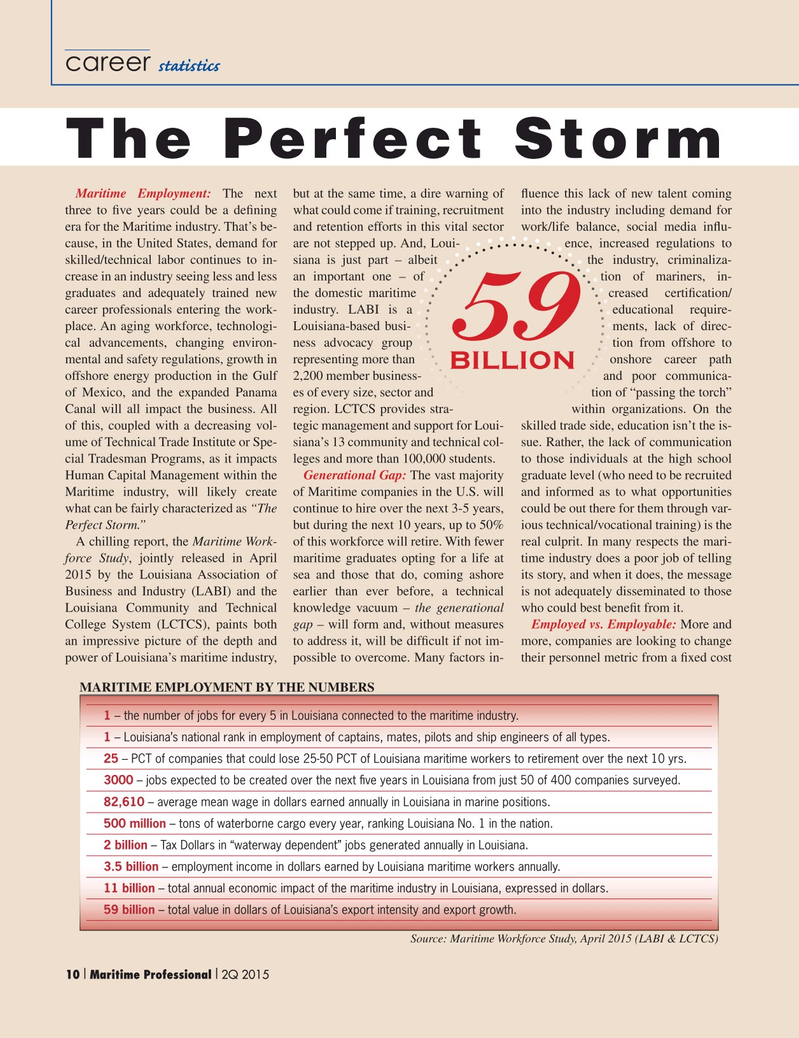
Page 10: of Maritime Logistics Professional Magazine (Q2 2015)
Read this page in Pdf, Flash or Html5 edition of Q2 2015 Maritime Logistics Professional Magazine
career statistics
The Perfect Storm
Maritime Employment: The next but at the same time, a dire warning of ? uence this lack of new talent coming three to ? ve years could be a de? ning what could come if training, recruitment into the industry including demand for era for the Maritime industry. That’s be- and retention efforts in this vital sector work/life balance, social media in? u- cause, in the United States, demand for are not stepped up. And, Loui- ence, increased regulations to skilled/technical labor continues to in- siana is just part – albeit the industry, criminaliza- crease in an industry seeing less and less an important one – of tion of mariners, in- graduates and adequately trained new the domestic maritime creased certi? cation/ career professionals entering the work- industry. LABI is a educational require- place. An aging workforce, technologi- Louisiana-based busi- ments, lack of direc- 59 cal advancements, changing environ- ness advocacy group tion from offshore to mental and safety regulations, growth in representing more than onshore career path billion offshore energy production in the Gulf 2,200 member business- and poor communica- of Mexico, and the expanded Panama es of every size, sector and tion of “passing the torch”
Canal will all impact the business. All region. LCTCS provides stra- within organizations. On the of this, coupled with a decreasing vol- tegic management and support for Loui- skilled trade side, education isn’t the is- ume of Technical Trade Institute or Spe- siana’s 13 community and technical col- sue. Rather, the lack of communication cial Tradesman Programs, as it impacts leges and more than 100,000 students. to those individuals at the high school
Human Capital Management within the Generational Gap: The vast majority graduate level (who need to be recruited
Maritime industry, will likely create of Maritime companies in the U.S. will and informed as to what opportunities what can be fairly characterized as “The continue to hire over the next 3-5 years, could be out there for them through var-
Perfect Storm.” but during the next 10 years, up to 50% ious technical/vocational training) is the
A chilling report, the Maritime Work- of this workforce will retire. With fewer real culprit. In many respects the mari- force Study, jointly released in April maritime graduates opting for a life at time industry does a poor job of telling 2015 by the Louisiana Association of sea and those that do, coming ashore its story, and when it does, the message
Business and Industry (LABI) and the earlier than ever before, a technical is not adequately disseminated to those
Louisiana Community and Technical knowledge vacuum – the generational who could best bene? t from it.
College System (LCTCS), paints both gap – will form and, without measures Employed vs. Employable: More and an impressive picture of the depth and to address it, will be dif? cult if not im- more, companies are looking to change power of Louisiana’s maritime industry, possible to overcome. Many factors in- their personnel metric from a ? xed cost
MARITIME EMPLOYMENT BY THE NUMBERS 1 – the number of jobs for every 5 in Louisiana connected to the maritime industry.
1 – Louisiana’s national rank in employment of captains, mates, pilots and ship engineers of all types.
25 – PCT of companies that could lose 25-50 PCT of Louisiana maritime workers to retirement over the next 10 yrs.
3000 – jobs expected to be created over the next

 9
9

 11
11
